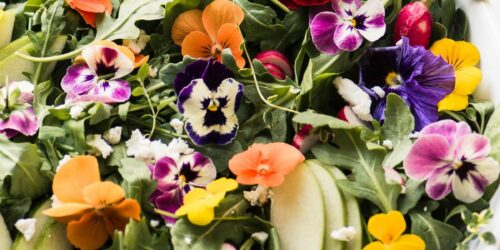When the long-awaited spring arrives, in the same way that the countryside fills with color, the greengrocers also do so with the variety of fruits and vegetables that nature offers us in this season of the year. It is important to respect the temporality of the fruits that the earth offers us, since it provides multiple benefits for farmers, consumers and implies less deterioration of our planet.
Below, we have prepared a seasonal low-histamine food list. We are especially interested in because of their nutrients. You will also find more information about other suitable foods in the low-histamine foods table that you can download it for free.
- Cherry: Cherries can be considered one of the most desired fruits by many consumers at this time of year and, in addition, they are low in histamine! They are characterized by their intense red color, a fleshy pulp and their sweet, smooth and delicate flavor that makes them very appetizing to include in everyday life. They contain many vitamins; among them A, C and E, folates and minerals such as magnesium, potassium, calcium, copper and phosphorus. On the other hand, they present antioxidants such as quercetin, lutein and zeaxanthin, which are responsible for the intense red color. If you are fructose or sorbitol intolerant, do not consume more than 2 per meal.
- Apricot: The arrival of these small and delicious fruits indicates that we are approaching the season of color and good weather. Due to their delicious flavor and their practicality to eat them, they turn out to be a great option for low-histamine diets. It stands out for its high content of vitamin C and beta-carotene, two powerful antioxidants. Specifically, beta-carotene contributes to the health of the eyes, skin, hair, mucous membranes, bones and the immune system. It also contains minerals such as potassium, calcium, magnesium and phosphorus. In addition to being able to eat fresh apricots, we can also prepare homemade apricot jam, compotes or even include them to sweeten some low-histamine recipes. If you are sorbitol intolerant, do not consume more than 1 per meal.
- Raspberries: Raspberries are a fantastic option to replace citrus fruits in low-histamine diets, as they contain a large amount of vitamin C. They are also rich in folate, potassium and calcium. We can consume them alone or, also, an idea of using them in a breakfast can be with a natural soy yogurt and oat flakes. In this way, we avoid resorting to buying flavored yogurts, which contain a lot of added sugars. Additionally, they are widely used in pastry recipes, since they provide an acid touch and at the same time sweet. And, finally, take note: if you detect that they spoil right away, store them in the freezer just the first day you buy them. When you are going to consume them, leave them for a few seconds under the tap and they defrost immediately. It is one of the few fruits suitable for most intolerances or intestinal inflammatory situations. That is why we like to use it so much in the menus of our patients.
- Red pepper: A great ally to protect the eyes, the digestive system, contribute to cardiovascular health and strengthen the body’s antioxidant defenses. It has a high water content and provides a high concentration of micronutrients and fiber. Did you know that pepper is one of the foods that contains the most vitamin C? So we are in front of a real gem and, in addition, it is histamine free! It is worth noting its lycopene content, a component with antioxidant action. In addition, it provides us with beta carotene (precursor of vitamin A), vitamin E and vitamin B6. Due to its high proportion of potassium and low in sodium, the pepper has a certain diuretic action. It also contains phosphorus, magnesium and calcium, essential minerals for the proper functioning of muscles, nerves, bones and teeth, among other factors. They can be used in many dishes; from a sauce to dip with some potatoes, stuffed or use them as a side dish in a main plate. If you are fructose intolerant, consume it in moderation. Maximum 1/4 of product per meal.
If you want us to advise you in a personalized way, either in our Barcelona nutrition centre or by video conference from anywhere in the world, contact us and we will help you
- Peas: Although peas are usually present throughout the year, in their fresh presence, it is during the spring months. In relation to its nutrients, its high content in proteins and B vitamins stands out, but also in other minerals such as potassium, copper, phosphorus, magnesium and calcium. A simple and quick recipe idea is peas with ham, a classic of the Mediterranean diet and it is a perfect option if you are in Phase 1 of the low-histamine diet. The ideal would be to consume the peas directly from the pod, not too much cooked, so that they do not lose nutrients. And, for those who like to innovate in the kitchen, another more original but no less delicious option can be a pea guacamole. If you have bacterial overgrowth, the consumption will be limited due to its mannitol, fructan and GOS content. Although in vegan diets, we will resort to the consumption of isolated pea protein powder.
- Asparagus: Asparagus stands out for being one of the richest vegetables in protein. Specifically, they are rich in the amino acid arginine, which plays an important role in skin health and wound healing, as it acts on collagen synthesis. On the other hand, they have a high content of vitamin C, folate and zeaxanthin. The latter is a flavonoid that acts on the retina together with lutein by filtering the harmful UV rays of the sun. If you have a deficiency of the Diamine Oxidase enzyme (DAO) you can enjoy this magnificent vegetable without any problem, since they have a low level of histamine. A different and exquisite way of consuming them can be through an asparagus soup or even in a warm salad. Out of curiosity… Did you know why urine smells after eating asparagus? It turns out that asparagusic acid generates different volatile compounds, among which we find sulfur derivatives with unpleasant aromas that remain in the urine. If you are fructose intolerant, consume it in moderation. Maximum 2-5 units per meal. But if you also have bacterial overgrowth, try not to reach this amount due to its fructan content.



